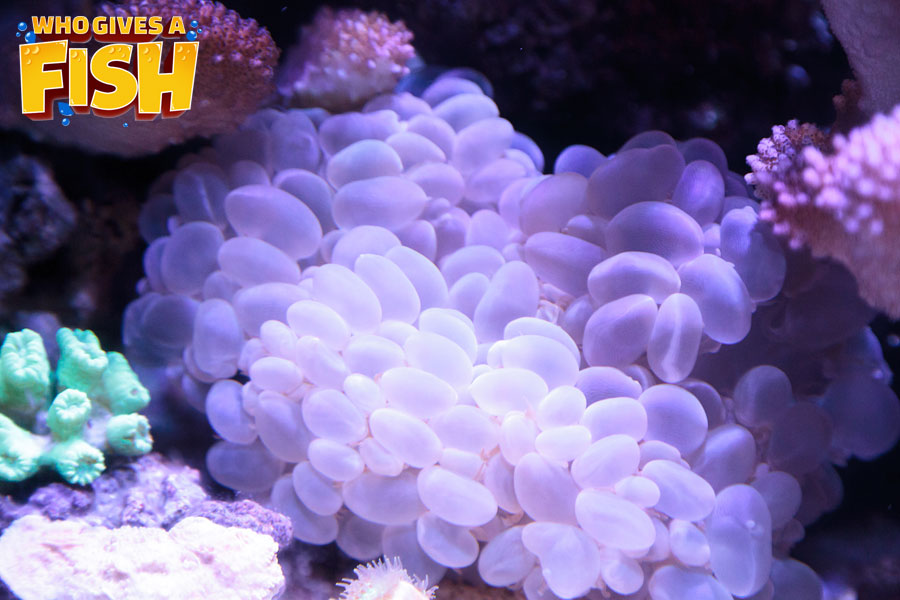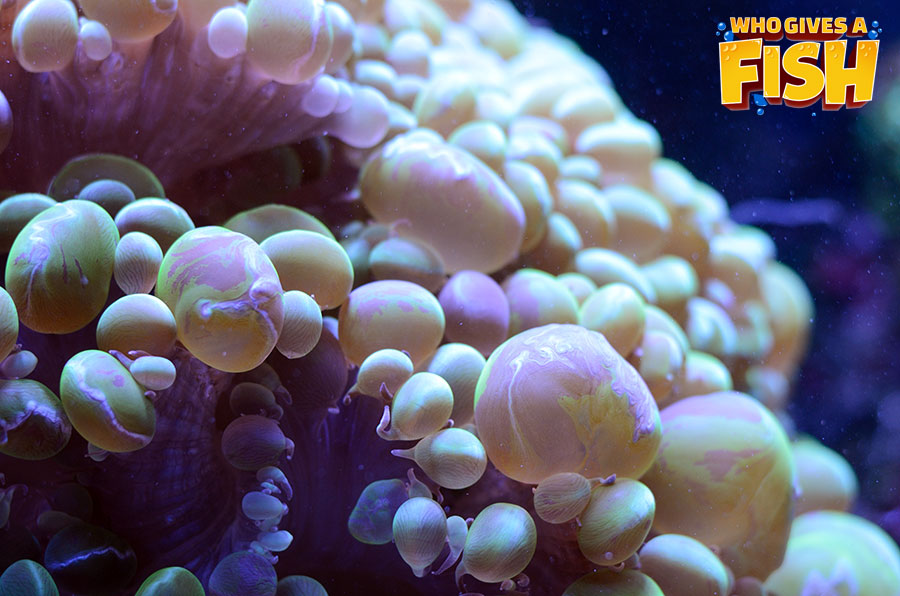Bubble Coral
The Bubble Coral, Plerogyra sinuosa, is a coral easily found and regularly seen in the aquarium trade. The Plerogyra spp. or “Grape Corals” will inflate and deflate their bubbles (vesicles) depending on how much lighting is available to them.
The Plerogyra genus is also found with some branching varieties. There can be little tips found on the ends of these bubbles, where one of its close relatives the Pearl Coral/Octobubble, Coral Plerogyra gets its name from.
- Experience Level: Intermediate
- Hardiness: Sensitive to poor water and bright lighting
- Minimum Tank Size: 50 gal (190 L)
- Lighting Needs: Low to moderate
- Temperature: 74° – 83° F (23° – 28° C)
- Gravity: 1.023 – 1.025
Table of Contents
Introduction
Aquarium Setup
Difficulty
Feeding
Breeding and Social
Grape Corals all have lightweight skeletons that consist of short, thick stalks that are topped with corallites. Its water filled vesicle bubbles will hide the corals skeleton. These bubbles will retract at night and only be seen during daylight hours. At night when they are retracted, their tapered feeding tentacles will come out to feed. You need to be aware that although the bubbles do not have toxins, their feeder tentacles will sting.
Bubble Corals are easily cared for and normally not very expensive which makes it a desirable coral among many hobbyists. As well as the fact that it comes in many colors, including tan, cream, green and shades of blueish green. Colonies of these Bubble Corals will form flat round clusters resembling a bunch of grapes.
P. sinuosa are happy with low lighting conditions and soft water flow. They will also do well with stronger lighting as well provided they are allowed to slowly acclimatize to it. Regular feeds and ensuring their delicate bubble tissue isn’t damaged, will see healthy lives for these corals.
The Bubble Coral, P. sinuosa, as well as the Octobubble Coral, P. flexosa, will be found in one colony with many large bubbles filled with water, making them very easily recognizable. “Octobubble” is derived from the bubbles found on the Octobubble Coral, having “nipples” at the tips.
The branching variation of this coral, Bubble Coral, P. simplex is quite similar looking to the P. sinuosa, just having branches as the defining factor. These bubble groupings will hardly touch each other due to the space that’s between them all. P discus looks almost exactly the same to the Fox Coral, Nemenzophyllia turbida as it has a similar flowery look to it, but instead each of the puffy vesicles are connected to separate branches.
Whether they are found as branching or not, The Plerogyra genus typically has a lightweight skeleton that is quite easy to cut and sever. Their vesicle bubbles are about 1/2 – 1” (1 – 1.25 cm) that are oval shaped and filled with water. They also have a very high density of zooxanthellae than found in most other symbiotic corals. The bubbles are not considered as polyps but instead described as tentacles that are modified to protect the actual polyps beneath them. Bubbles will expand or deflate as they need to acquire more or less light during the day time, before deflating at night. At night, feeder tentacles that are approx. 3 – 4” (7.5 – 10 cm) will emerge to begin catching prey- these have a sting to them! Small tentacles that are seen with the bubbles during the day time do not have stinging capabilities.
The Plerogyra spp. will be found in a range of shades of tan, cream and bluish green-green. There will be lighter striations on the surface and will turn a brown color if lighting is too intense. There will generally be small pieces of delicate, sharp, thin “bone” known as “septa” in between the bubbles. Tissue from the Plerogyra genus are known to connect with and actually encrust over nearby substrates. Colonies have been found over 3 feet (1 m) in the ocean, with the majority of them only reaching around 17” (19 cm). Their lifespan is currently unknown.
Aquarium Setup
A healthy, well fed aquarium with live rock is required for the Bubble Coral. Fish creating organic material will also be beneficial for them. It is recommended, as with all corals to have a mature tank before adding them.
Provide them with gentle water flows and low-moderate strength lighting. Make sure they are never put under bright lighting unless this is done very slowly allowing them to acclimatize over a long period. Feeding them regularly is ideal with caution being given to not damage their sensitive tissues. Ensure that no other corals come into contact with your Bubble Coral as they are rated as being an aggressive species that can sting other corals.
Bubble Coral Aquarium and Parameter Checklist
- Minimum Tank Size: 50 gal (190 L)
- Lighting Needs: Low to Moderate
- Temperature: 74° – 83° F (23° – 28° C)
- Specific gravity: 1.023 – 1.025
- Alkalinity Levels: 3.5 – 4.8 MEQ/L (8 – 11 dKh)
- Calcium: 380 – 430 ppm
- Phosphates: 0 (Avoid Phosphates)
- Magnesium Levels: 1200 – 1350
- Strontium Levels: 8 – 10
- Water Movement: Low – Medium
- Tank Region: Bottom
Difficulty
The Bubble Coral is a fairly easy one to take care of, provided you follow maintain the ideal parameters and manage lighting requirements accordingly. Avoid other corals in the immediate vicinity to stop them stinging each other.
Feeding
LPS corals have developed various feeding methods. Planktonic organisms and microscopic food particles will be captured from within the water column. Dissolved organic matter will be absorbed as well. They have a symbiotic relationship with marine algae, also called zooxanthellae from where they can source some of their nutrients as well.
In your home aquarium, feed them when their feeder tentacles come out at night with foods such as enriched brine shrimp, Cyclopeeze, rotifers and mysis and other meaty foods of a similar size. Feeding larger pieces is not ideal as it makes it hard for the corals to digest these and many of them will just regurgitate them later on at night. This will lead to eventual malnutrition and starvation.
Breeding
LPS corals are male and female and will reproduce both sexually and asexually. They will reproduce in the wild by releasing sperm and eggs at the same time which results in the eggs being fertilized and turning into free-swimming planula larva. These Larva will eventually settle on some substrate becoming plankters. Calcium carbonate is then excreted from tiny polyps that are formed and will develop into a coral. Planula larvae are very vulnerable to being eaten and only few survive this process.
Bubble Coral can also reproduce asexually as well. Tissues from the Plerogyra genus can connect onto and encrust substrates that are close by and like to grow vertically. Sometimes this will result in a new “bud” that will eventually form a new colony.
Physical propagation of these should only ever be attempted on the branching variety. Its encrusting behaviors should be left to propagate it if required. Cutting into any of their tissues will result in damage, leading to disease and eventual death. Keeping them well fed and comfortable will see them produce new buds on their own, often forming a few new colonies each year. With some patience, your coral will grow and provide offspring for you on its own accord.
In order to propagate branching colonies, you will need to start with a nice healthy Bubble Coral that isn’t showing any signs of ill health or stress. All you need to do is cut at least 2” inches away from the head to avoid damaging any of the bubble tissues. Glue these new frags onto rubble or plugs and provide them stable environments to recover with plenty of flow. Slime that is produced by them during this should never come into contact with other corals, and gloves should always be worn.
Social
Bubble Corals are known to be aggressive if they come into contact with other corals. They should always be placed with plenty of space between them and other corals in the tank. At least 6” is recommended as their sweeper tentacles can reach this far when they come out at night. These feeders also pack a punch with a sting that can also hurt humans.
Toxins produced by leather corals will kill them so never house them together. Hermit crabs will also irritate the flesh of these corals.



